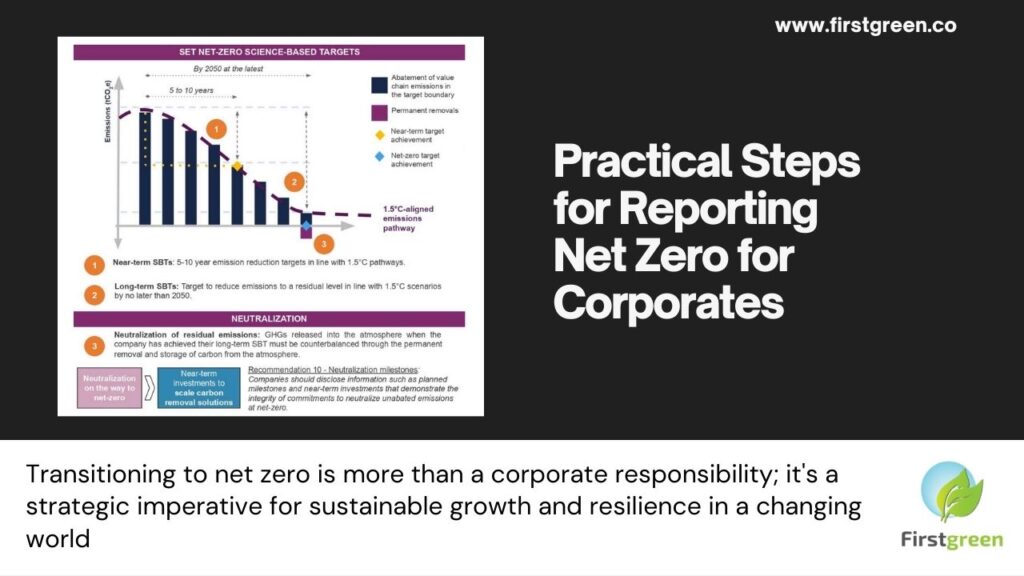Practical Steps for Reporting Net Zero for Corporates

In the current global landscape, achieving net zero emissions has become an essential goal for corporations. Reporting on net zero efforts not only demonstrates a company’s commitment to sustainability but also enhances transparency and credibility with stakeholders. Here are practical steps for corporates to effectively report their journey towards net zero:
1. Understand the Science Based Targets Initiative (SBTi) Standards
The Science Based Targets initiative (SBTi) provides a robust framework for setting and reporting net zero targets. Companies should familiarize themselves with the SBTi Corporate Net-Zero Standard, which outlines the necessary steps to align corporate strategies with the Paris Agreement goals.
2. Set Science-Based Targets (SBTs)
- Near-term SBTs: These are 5-10 year emission reduction targets aligned with 1.5°C pathways. They act as critical milestones towards achieving long-term goals.
- Long-term SBTs: Aimed at reducing emissions to residual levels in line with 1.5°C scenarios by no later than 2050.
3. Develop a Comprehensive Emissions Inventory
- Scope 1 and 2 Emissions: These include direct emissions from owned or controlled sources and indirect emissions from the generation of purchased energy.
- Scope 3 Emissions: Indirect emissions occurring in the value chain of the reporting company, including both upstream and downstream emissions.
Ensure the inventory covers at least 95% of company-wide scope 1 and 2 emissions and a comprehensive scope 3 inventory.
4. Neutralize Residual Emissions
- Neutralization: Companies must neutralize any remaining emissions through measures that permanently remove carbon from the atmosphere, such as reforestation or carbon capture and storage.
- Beyond Value Chain Mitigation (BVCM): Invest in projects that mitigate emissions outside of the company’s value chain, such as renewable energy projects or jurisdictional REDD+ credits.
5. Implement Mitigation Strategies
- Reduce Value Chain Emissions: Implement strategies to reduce emissions across the entire value chain, including production processes, supply chain logistics, and product lifecycle management.
- Invest in Renewable Energy: Transition to renewable energy sources to reduce dependency on fossil fuels and lower scope 2 emissions.
- Enhance Energy Efficiency: Adopt energy-efficient technologies and practices to minimize energy consumption.
6. Monitor and Report Progress
- Annual Reporting: Disclose target progress annually through sustainability reports or dedicated climate action reports. Ensure transparency and accuracy in reporting methods.
- Third-Party Verification: Engage independent third-party verifiers to validate the emissions data and the effectiveness of mitigation measures.
- Adjust Targets and Strategies: Regularly review and adjust targets and strategies based on progress and new scientific insights.
7. Engage Stakeholders
- Internal Engagement: Foster a culture of sustainability within the organization by involving employees at all levels in the net zero journey.
- External Communication: Clearly communicate net zero commitments and progress to stakeholders, including investors, customers, and regulatory bodies.
8. Leverage Technology and Innovation
- Digital Tools: Utilize digital tools and platforms for accurate data collection, monitoring, and reporting.
- Innovative Solutions: Invest in innovative technologies such as AI and IoT for real-time monitoring and optimization of energy use and emissions.
9. Follow Sector-Specific Guidance
Refer to sector-specific guidance provided by the SBTi to tailor net zero strategies and reporting practices to the unique challenges and opportunities within your industry.
By following these practical steps, corporates can effectively report their net zero efforts, enhancing transparency and accountability while contributing to global climate goals. This structured approach not only aligns corporate actions with scientific standards but also reinforces the company’s commitment to sustainability and long-term value creation.